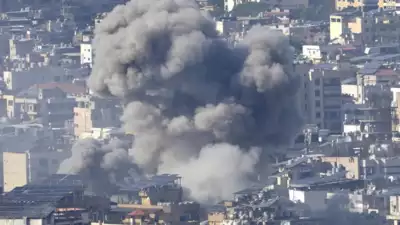
Israel carried out at least two airstrikes in a western neighborhood of Damascus and one of the capital’s suburbs on Thursday, killing at least 15 people and wounding another 16, Syria’s state news agency said.
Airstrikes in the Mazzeh neighborhood of Damascus and the suburb of Qudsaya, northwest of the capital, hit two buildings, SANA news agency said. An Associated Press reporter on the scene in Mazzeh said the five-story building was destroyed by a missile that hit the basement.
The Israeli military said it had struck infrastructure sites and command centers of the Islamic Jihad militant group in Syria, and “caused significant damage to the terrorist organization’s command center and its operatives”.
The airstrikes in Damascus and its suburbs came shortly before Ali Larijani, an adviser to Iran’s supreme leader Ali Khamenei, was scheduled to meet in the Syrian capital with representatives of Palestinian factions at the Iranian Embassy in Mazzeh.
The Israeli military said Islamic Jihad was involved with Hamas, a Palestinian militant group in the Gaza Strip, in an October 7, 2023 attack in southern Israel that killed around 1,200 people – mostly civilians – and saw another 250 abducted into Gaza.
The military “will continue operations against the Islamic Jihad terrorist organization wherever necessary,” he said.
Israel’s response to the October 7 attacks and the Israel-Hamas war has spilled over into the wider region, affecting Lebanon, Syria and sparking clashes between Israel and Iran. The war has devastated much of Gaza and killed more than 43,000 Palestinians, mostly women and children, according to local health authorities who do not distinguish between civilians and fighters.
Officials with the Palestinian Islamic Jihad Group said the attack in Mazzeh targeted one of its offices, and several members of the group were killed. The official spoke on condition of anonymity because he is not authorized to speak to the media.
Syria’s state news agency SANA said the country’s air defenses were activated against “hostile targets” south of the central city of Homs. It did not provide further details.
Tehran has been a key supporter of Syrian President Bashar Assad’s government since the 2011 uprising turned into a full-blown civil war and has played a key role in turning the tide of the conflict.
Iran has sent many military advisers and thousands of Iran-backed fighters from around the Middle East to Syria to fight on Assad’s side. Tehran has also been an economic lifeline for Assad, delivering fuel and lines of credit worth billions of dollars.
Israel has carried out hundreds of airstrikes in Syria targeting members of the Lebanese Hezbollah and officials from the Iran-backed group.
Hezbollah began firing into Israel on October 8, 2023, in solidarity with Hamas in Gaza. Since then, more than 3,200 people have been killed in Lebanon and more than 14,200 injured, the country’s Ministry of Health reported. In Israel, 76 people have been killed, including 31 soldiers.
Lebanese state media said an Israeli airstrike hit a building in the eastern Lebanese city of Baalbek, killing at least nine people and wounding five others.
The attack on Baalbek came without warning. The Israeli military did not immediately comment and the targets were unclear.
Israeli warplanes intensified airstrikes on Thursday, targeting various areas in southern and eastern Lebanon, including the southern port city of Tire and Nabatieh province, the National News Agency said.
Throughout the day, sporadic airstrikes hit Beirut’s southern suburbs in an apparent attack on the area over the past two days, with the Israeli army issuing an evacuation warning for several locations and buildings on the outskirts of the city.
The Israeli military said it carried out strikes against Hezbollah targets in the Dahiyeh area, including weapons storage facilities and a command center.
Lebanon’s Ministry of Health said that the number of dead in Lebanon since the war since October 8, 2023 has reached 3,365, while the wounded are 14,344. Nearly 1.2 million people have been displaced.
Before the fighting intensified on September 23, Hezbollah said it had lost nearly 500 members, but the group stopped short of releasing a statement on the number of fighters killed.
UN peacekeeping chief Jean-Pierre Lacroix, speaking during a visit to Lebanon, said the UN remained committed to maintaining peacekeeping forces, known as UNIFIL, in all positions in southern Lebanon, despite ongoing fighting between Israeli and Israeli forces. Hezbollah militants.
UNIFIL continues to monitor the escalating conflict between Israel and Hezbollah across the border known as the Blue Line despite Israeli demands that peacekeepers withdraw five km (three miles) from the border. UNIFIL has accused Israel of deliberately destroying observation equipment, and 13 peacekeepers have been injured in the fighting.
Lacroix visited several wounded peacekeepers during the trip.
UNIFIL troops “continue to be deployed in all positions, and we think it is very important to maintain that presence everywhere,” LaCroix said. “…If we vacate some positions, it will certainly jeopardize UNIFIL’s capacity to continue today, but more importantly, it will undermine UNIFIL’s capacity to play its role, tomorrow, when the cessation of hostilities takes place – hopefully sooner.”
Lacroix said there is still “a large consensus that resolution 1701 remains the critical framework for a settlement,” referring to the UN Security Council resolution that ended the brutal war between Israel and Hezbollah in 2006, but has never been fully implemented by either side. .




